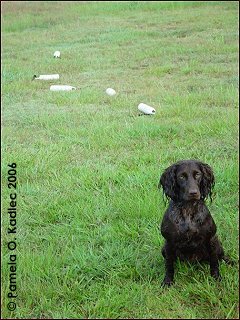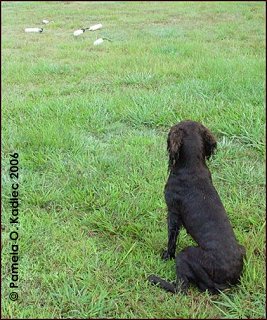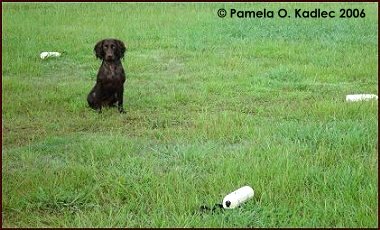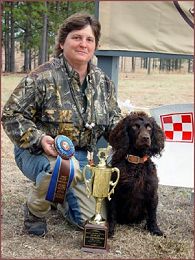
|
Nine times out of ten your pup doesnít find the bird because he wonít hunt deep enough. When this happens, you have to get up off your dove stool and walk out with pup while encouraging him to "hunt it up". How neat it would be if you could cast your pup back to find your birds.
You have been diligently training pup getting ready for opening day. Your feather fetcher hasnít been lying around under the porch all summer getting fat and lazy - and you havenít been doing time in the recliner enjoying baseball and the air conditioning. Right? Good. Youíve been reading the articles in this magazine and following along all year, keeping pup on a check cord, getting him to swing with the gun and training with your hunting buddy and his dog. Pup is steady to the shot and is pretty reliable about delivering to hand. Now itís time to teach him to take a cast to go back.
In one session you will do several drills, mixing things up so that pup doesnít get bored. Two different lining drills - lining to a pile and wagon wheel - and walking baseball. You will also teach pup to "hunt dead" so that once pup is in the area of the bird he will put his nose to the ground and find the bird without any more direction from you. That way, if you know the approximate area of where the bird fell, but not exactly, you can get pup into the general area and heíll come up with the bird.
Teaching pup to Ďhunt deadí is a cue to the dog to use some initiative and start trying harder to find the bird. I start puppies off with Goldfish crackers, dropping them on the ground and telling pup to "find it" and "hunt dead". If pup looks at you as if you are nuts, gently push his head down toward the cracker until he gets a nose full. Praise him as if he's found gold instead of Goldfish and repeat the exercise. Once pup starts using his nose as soon as you say, "hunt dead" youíve got half the battle won. Sit pup down and toss a bumper into cover. Release pup and if he has any trouble marking the bird, go out with him and encourage him to "hunt dead".
Next time out leave pup on the truck for a few minutes while you toss a couple of bumpers or birds into some moderate cover. Bring pup out and toss a few marks in another direction to get pup into a working mode. Take him over to the edge of the cover and encourage him to Ďhunt deadí. If heís confused, walk out with him and talk excitedly to him, "dead bird, hunt dead". If he still canít find the bumper kick it up and repeat the Ďhunt deadí. Praise the heck out of pup when he comes up with the bird. Send him out again to find the other bumper or bird. As pup learns this game, back up further and further until pup will hunt on his own.
To get a pup to go backwards and hunt he first needs to understand what Ďbackí means. Even if pup is steady, put a 25-foot check cord on him and find an area with short cover. Sit pup and walk away with him facing you. Toss a bumper over his head. He will most likely turn to retrieve or at least turn his head to see where the bumper lands. You use the check cord to stop him if he breaks or to gently pull his head back around to face you. Tell pup to "look at me" and when you have eye contact, raise your arm straight up, palm facing pup, and say, "back!" Do not release pup until he looks at you.
If pup doesnít understand what you want, move toward him and encourage him with your body English to turn and fetch. Repeat this exercise up to ten times and pup should get the idea of this new game. To keep pup cooled off, sit him with his back to a pond and toss the bumpers back into the water. Alternate between water and land casts so that pup isnít always expecting to get wet.
For the lining drill, sit pup down and walk away carrying several (no more than eight a session) bumpers, preferably white ones. Let pup watch you toss the bumpers down (in short cover) and walk back to him. Heel him away from the pile a few yards and turn back to face the bumpers. Tell pup, "dead bird" and when he is locked in on the pile, send him with "back". If pupsí rump, head and nose are all lined toward the pile of bumpers it isnít necessary to put your hand down over pupsí nose to point him in the right direction. Some handlers feel it cues pup for a blind retrieve but using the word, "dead" and when pup is looking out to the pile say, "good", are enough cues that this isnít a mark.
When pup returns, move back another five to ten yards and send him again. Keep moving back as long as pup is successful. If he starts wandering or hunting, stop him and bring him back in. Move him up closer until he sees the bumpers and finish on a positive note. Toss a couple of marks to end the session and to break the monotony of the drills.
Continue the lining drill in the same spot until pup has confidence to go straight out every time for about one hundred yards. Only then will you move the pile to a different area and start all over again. Once pup is taking a line for 30 yards you can start playing the wagon wheel drill. Heel pup to an area where you can throw four to eight bumpers around you in a circle. At first only use four bumpers in short cover. Imagine a clock and toss one at 12:00, 3:00, 6:00 and 9:00. Line pup up for the first one, when his rump and his nose are pointing in the same direction, say, "good", then "back!" When pup returns with the bumper, keep him facing where he just came from and toss the bumper back in the same spot.
Tell pup, "no bird" and wheel him around to the next bumper in the circle. Continue the game for all four bumpers.
The last drill you will work pup on is a version of walking baseball. This will teach pup the basics of handling while having some fun. You can do this drill after the lining drills since itís more like marks and the dog gets excited and ready to play. With pup walking around, toot for a sit and toss the bumper any direction you want. Get pup to look at you and cast him to the bumper. If you can, work near water alternate casting pup into the water and on land.
At the next lesson, take two bumpers and when pup is going after one, toss the other in a direction that pup doesnít see. Hold onto the bumper pup delivers, then have pup stay seated and walk away from him. Now, cast him to the other bumper. If he doesnít take the cast, toot for a sit and toss the bumper you are holding to the same spot. Receive the bumper from pup at the same spot he just left and cast him again to the other bumper still down. If heís successful start over - toss one bumper and as pup is going out, toss the other in a different direction. Each lesson consists of no more than ten throws.
Continue the lining drills along with the walking baseball. Throw in some sit to the whistle drills (carry treats, toot for a sit and toss a treat) and before you know it, pup will be driving back into cover finding your birds while you conserve your energy at the dove stool. Happy hunting!
|
|
| Bookstore | Bill Fawcett Reviews | Bookshelf | Advertise | Classifieds | Resources | Events | Point Standings | Archives | |
|
|
Copyright © Spaniel Journal & L Baughan Webdesign, 2002-2006, all rights reserved worldwide |
|



